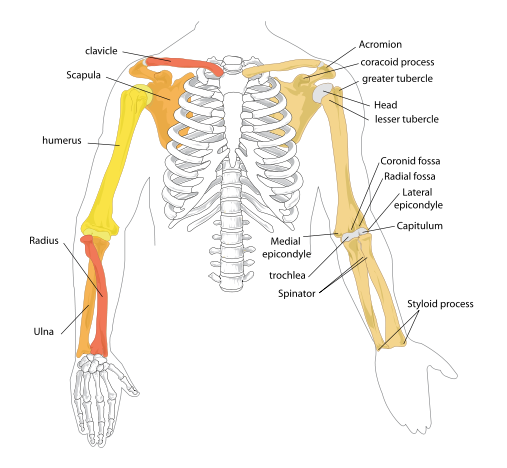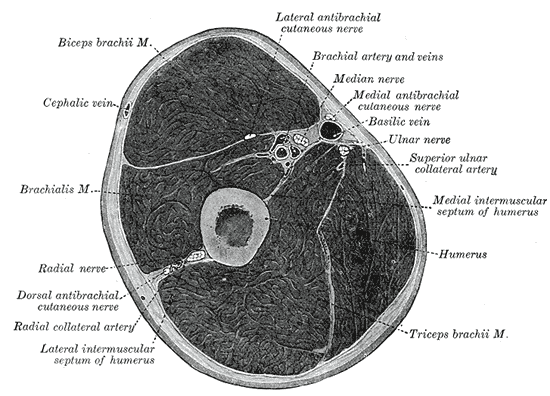Arm
|
WikiDoc Resources for Arm |
|
Articles |
|---|
|
Media |
|
Evidence Based Medicine |
|
Clinical Trials |
|
Ongoing Trials on Arm at Clinical Trials.gov Clinical Trials on Arm at Google
|
|
Guidelines / Policies / Govt |
|
US National Guidelines Clearinghouse on Arm
|
|
Books |
|
News |
|
Commentary |
|
Definitions |
|
Patient Resources / Community |
|
Directions to Hospitals Treating Arm Risk calculators and risk factors for Arm
|
|
Healthcare Provider Resources |
|
Continuing Medical Education (CME) |
|
International |
|
|
|
Business |
|
Experimental / Informatics |
Editor-In-Chief: C. Michael Gibson, M.S., M.D. [1]
Overview
In anatomy, an arm is one of the upper limbs of an animal. The term arm can also be used for analogous structures, such as one of the paired upper limbs of a four-legged animal, or the arms of an octopus. Anatomically, the term arm refers specifically to the segment between the shoulder and the elbow. The segment between the elbow and wrist is the forearm. However, in colloquial speech the term arm often refers to the entire upper limb from shoulder to wrist.
In primates the arms are richly adapted for both climbing and for more skilled, manipulative tasks. The ball and socket shoulder joint allows for movement of the arms in a wide circular plane, while the presence of two forearm bones which can rotate around each other allows for additional range of motion at this level.
Anatomy of the human arm
The human arm contains bones, joints, muscles, nerves, and blood vessels. Many of these muscles are used for everyday tasks.
Bony structure and joints

The humerus is the (upper) arm bone. It joins with the scapula above at the shoulder joint (or glenohumeral joint) and with the ulna and radius below at the elbow joint.
Elbow joint
The elbow joint is the hinge joint between the distal end of the humerus and the proximal ends of the radius and ulna. The upper arm bone is not easily broken. It is built to handle pressure of up to 300lbs.
Osteofascial compartments
The arm is divided by a fascial layer (known as lateral and medial intermuscular septa) separating the muscles into two osteofascial compartments:
The fascia merges with the periosteum (outer bone layer) of the humerus. The compartments contain muscles which are innervated by the same nerve and perform the same action.
Two other muscles are considered to be partially in the arm:
- The large deltoid muscle is considered to have part of its body in the anterior compartment. This muscle is the main abductor muscle of the upper limb and extends over the shoulder.
- The brachioradialis muscle originates in the arm but inserts into the forearm. This muscle is responsible for rotating the hand so its palm faces forward (supination).
Cubital fossa
The cubital fossa is clinically important for venepuncture and for blood pressure measurement. It is an imaginary triangle with borders being:
- Laterally, the medial border of brachioradialis muscle
- Medially, the lateral border of pronator teres muscle
- Superiorly, the intercondylar line, an imaginary line between the two condyles of the humerus
- The floor is the brachialis muscle
- The roof is the skin and fascia of the arm and forearm
The structures which smell through the cubital fossa are vital. The order from which they pass into the forearm are as follows, from medial to lateral:
- Median nerve, which starts to branch
- Brachial artery
- Tendon of the biceps brachii muscle
- Radial nerve
- Median cubital vein - this important vein is where venepuncture occurs. It connects the basilic and cephalic veins.
- lymph nodes
Nervous supply
The musculocutaneous nerve, from C5, C6, C7, is the main supplier of muscles of the anterior compartment. It originates from the lateral cord of the brachial plexus of nerves. It pierces the coracobrachialis muscle and gives off branches to the muscle, as well as to brachialis and biceps brachii. It terminates as the anterior cutaneous nerve of the forearm.
The radial nerve, which is from the fifth cervical spinal nerve to the first thoracic spinal nerve, originates as the continuation of the posterior cord of the brachial plexus. This nerve enters the lower triangular space (an imaginary space bounded by, amongst others, the shaft of the humerus and the triceps brachii) of the arm and lies deep to the triceps brachii. Here it travels with a deep artery of the arm (the profunda brachii), which sits in the radial groove of the humerus. This fact is very important clinically as a fracture of the bone at the shaft of the bone here can cause lesions or even transections in the nerve.
Other nerves passing through give no supply to the arm. These include:
- The median nerve, nerve origin C5-T1, which is a branch of the lateral and medial cords of the brachial plexus. This nerve continues in the arm, travelling in a plane between the biceps and triceps muscles. At the cubital fossa, this nerve is deep to the pronator teres muscle and is the most medial structure in the fossa. The nerve passes into the forearm.
- The ulnar nerve, origin C7-T1, is a continuation of the medial cord of the brachial plexus. This nerve passes in the same plane as the median nerve, between the biceps and triceps muscles. At the elbow, this nerve travels posterior to the medial epicondyle of the humerus. This means that condylar fractures can cause lesion to this nerve.
Blood supply and venous drainage
Arteries
The main artery in the arm is the brachial artery. This artery is a continuation of the axillary artery. The point at which the axillary becomes the brachial is distal to the lower border of teres major. The brachial artery gives off an important branch, the profunda brachii (deep artery of the arm). This branching occurs just below the lower border of teres major.
The brachial artery continues to the cubital fossa in the anterior compartment of the arm. It travels in a plane between the biceps and triceps muscles, the same as the median nerve and basilic vein. It is accompanied by venae comitantes (accompanying veins). It gives branches to the muscles of the anterior compartment. The artery is in between the median nerve and the tendon of the biceps muscle in the cubital fossa. It then continues into the forearm.
The profunda brachii travels through the lower triangular space with the radial nerve. From here onwards it has an intimate relationship with the radial nerve. They are both found deep to the triceps muscle and are located on the spiral groove of the humerus. Therefore fracture of the bone may not only lead to lesion of the radial nerve, but also haematoma of the internal structures of the arm. The artery then continues on to anastamose with the recurrent radial branch of the brachial artery, providing a diffuse blood supply for the elbow joint.
Veins
The veins of the arm carry blood from the extremities of the limb, as well as drain the arm itself. The two main veins are the basilic and the cephalic veins. There is a connecting vein between the two, the median cubital vein, which passes through the cubital fossa and is clinically important for venepuncture (withdrawing blood).
The basilic vein travels on the medial side of the arm and terminates at the level of the seventh rib.
The cephalic vein travels on the lateral side of the arm and terminates as the axillary vein. It passes through the deltopectoral triangle, a space between the deltoid and the pectoralis major muscles.
See also
Additional images
-
Cross-section through the middle of upper arm.
External links
| Wikimedia Commons has media related to Arm. |
- Neuro-controlled bionic arm.
- Arm fractures
- Arm at the US National Library of Medicine Medical Subject Headings (MeSH)
- Template:EMedicineDictionary
Template:Human anatomical features
Template:Upper limb general
ar:ذراع cy:Braich da:Arm de:Arm eo:Brako eu:Beso fi:Käsivarsi ko:팔 id:Lengan it:Braccio (anatomia) la:Brachium (anatomia) lt:Ranka mg:Sandry nl:Arm (ledemaat) simple:Arm sk:Kostra hornej končatiny sv:Arm
